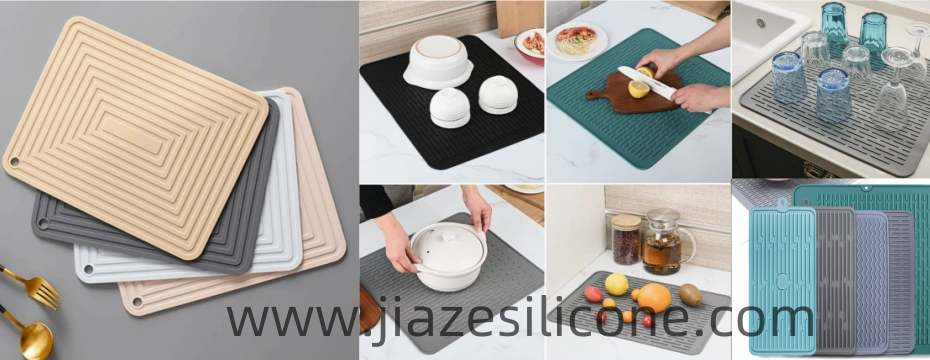When it comes to selecting the right drying mats, material quality, durability, and functionality are key factors. Liquid Silicone drying mats have gained popularity due to their non-slip properties, water resistance, and ease of cleaning. However, within silicone materials, there are two primary options: liquid silicone rubber and solid silicone. If both options are available at the same price, which one should you choose? This document explores the advantages and disadvantages of both, helping you make an informed decision.

Understanding Liquid Silicone and Solid Silicone
Liquid Silicone
Liquid silicone rubber (LSR) is a high-purity, flexible material that is created through a platinum-cured process. This type of silicone is often injection-molded, allowing for intricate designs and softer textures.
Solid Silicone
Solid silicone, in contrast, is a more rigid and traditional form of silicone that is usually compression-molded. It is firmer, less elastic, and often used in industrial applications due to its structural integrity.
Key Comparison Factors: Liquid Silicone Drying Mats are winner
1. Durability and Longevity
Liquid silicone is known for its flexibility and resistance to wear and tear. It is more resistant to cracking and breaking over time, making it a preferred choice for products that undergo frequent bending and stretching. Solid silicone, while durable, is more prone to becoming brittle over long periods of use, especially when exposed to heat and water continuously.
Winner: Liquid Silicone
2. Heat Resistance
Both types of silicone are heat-resistant, but liquid silicone has an edge due to its platinum-cured composition. It can withstand extreme temperatures better without losing its elasticity or structural integrity. Solid silicone, while also heat-resistant, may degrade faster in high-temperature environments.
Winner: Liquid Silicone
3. Water and Stain Resistance
A drying mat’s main function is to handle water exposure. Liquid silicone has better hydrophobic properties, meaning it repels water more efficiently and dries faster. This helps prevent mold and bacterial growth. Solid silicone, while also water-resistant, may retain moisture longer, leading to potential hygiene concerns over time.
Winner: Liquid Silicone
4. Texture and Comfort
Liquid silicone is softer and more pliable, providing a cushioned surface that can be beneficial for delicate dishware or glassware. Solid silicone tends to be harder and less flexible, which may not be ideal for fragile kitchen items.
Winner: Liquid Silicone

5. Maintenance and Cleaning
Both liquid and solid silicone mats are easy to clean, but liquid silicone has a smoother surface, making it easier to wipe down and less prone to accumulating dirt in crevices. Solid silicone may require more scrubbing, especially if it has a textured surface.
Winner: Liquid Silicone
6. Eco-Friendliness
Liquid silicone is often manufactured using a more refined and energy-efficient process, making it slightly more environmentally friendly than solid silicone. Additionally, its longer lifespan means less frequent replacements, reducing overall waste.
Winner: Liquid Silicone
7. Design and Aesthetic Appeal
Liquid silicone mats can be molded into intricate patterns, providing a more modern and sleek look. Solid silicone, due to its rigidity, offers fewer design options and may appear bulkier.
Winner: Liquid Silicone
8. Cost-Effectiveness
If both options are priced the same, liquid silicone provides better value due to its durability, flexibility, and overall performance. The additional benefits make it a more cost-effective option in the long run.
Winner: Liquid Silicone
Final Verdict
Considering all the factors, liquid silicone emerges as the superior choice if priced the same as solid silicone. It offers better durability, flexibility, heat resistance, and water resistance while being easier to clean and maintain.
If you’re looking for a drying mat that provides long-term benefits, hygiene, and convenience, liquid silicone is the better investment. However, if you prefer a firmer structure for specific uses, solid silicone may still be a viable option.
Recommendation:
Choose liquid silicone drying mats over solid silicone if they are available at the same price. The additional benefits ensure better performance and longevity, making it the smarter choice for everyday use.